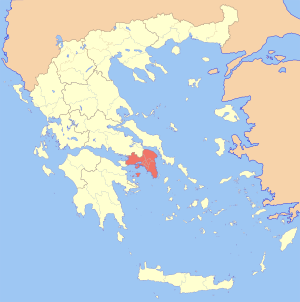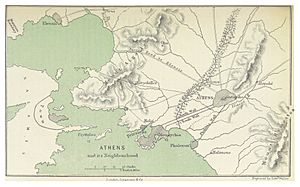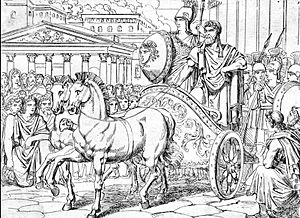Pisistratus facts for kids
Quick facts for kids
Pisistratus
|
|
|---|---|
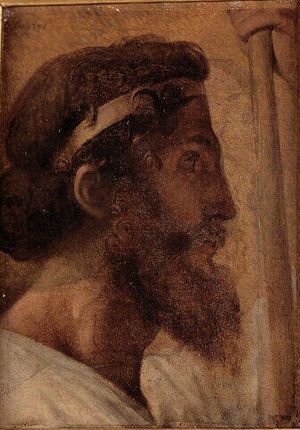
A fictitious depiction of Pisistratus from the 19th century.
|
|
| Tyrant of Athens | |
| In office 561 BC, 559–556 BC, 546–527 BC |
|
| Succeeded by | Hippias |
| Personal details | |
| Born | c. 600 BC Athens, Greece |
| Died | Spring 527 BC Athens, Greece |
Pisistratus (around 600 – 527 BC) was an important leader in ancient Athens. He ruled as a "tyrant" at different times from the 560s BC until his death. In ancient Greece, a tyrant was a ruler who took power without following the usual laws. They were not always seen as bad, like the word means today.
Pisistratus helped unite the region of Attica, where Athens is located. He also made big improvements to Athens' economy and culture. These changes helped Athens become a very powerful city in ancient Greece later on. He started the Panathenaic Games and helped create a standard version of the famous Homeric epics. Pisistratus also supported the poorer people of Athens. He took land from the rich and gave it to the poor. He also spent money on religious events and art to help the economy. This helped share wealth more fairly among the people.
The Pisistratids were Pisistratus and his two sons, Hipparchus and Hippias. They ruled Athens from 546 to 510 BC.
Contents
How Athens Was Ruled
In ancient Greece, governments often started as kingdoms. But by the 600s and 500s BC, rich families, called aristocrats, began to take control. These families had lots of land and power in the growing Greek city-states. Some famous Athenian families were the Pisistratids, Philaids, and Alcmaeonids. The Pisistratids believed they were related to a legendary king from the Bronze Age.
The Alcmaeonids were another powerful family. They sometimes fought against Pisistratus and sometimes supported him. Because these rich families often argued, it was hard to keep order. This made it possible for a "tyrant" to take power. A tyrant was someone who became ruler, usually by force, rather than being elected or inheriting the role.
One early example was Cylon, an Olympic champion. He tried to take control of the Acropolis around 636 or 632 BC. His attempt failed, and he and his supporters were killed by the Alcmaeonids. This event led to a famous "curse" on the Alcmaeonid family.
Solon was an Athenian leader and lawmaker. He was related to Pisistratus through his mother. In the early 500s BC, Solon changed Athens' social classes and laws. He ended debt slavery, which helped many poor Athenians. This eased their suffering and possibly stopped a civil war. Pisistratus later gained support from many of these common people.
Pisistratus's Early Life and Rise to Power
We don't know much about Pisistratus's early life. His father, Hippocrates, once saw a strange sign during the Olympic Games. A wise man told Hippocrates to disown his son if he had one. But Hippocrates did not listen, and Pisistratus was born.
Pisistratus first became known as a general. Around 565 BC, he captured the port of Nisaea from the city-state of Megara. This victory helped end a trade blockade that had caused food shortages in Athens.
After Solon left Athens, the city was still divided. Three main political groups fought for control. These groups were based on where people lived and how much money they had:
- Men of the Plain: These were rich landowners who grew grain. They were led by Lycurgus.
- Men of the Coast: These people lived along the sea, like fishermen and craftsmen. They were led by Megacles.
- Men of the Hill: These were the poorest people, living in the hills. They traded things like honey and wool. Pisistratus organized them into his own group. This group was much larger than the other two combined.
Pisistratus became popular after his victory against Megara. But he needed more power to take control. Around 561 BC, he tricked the Athenians. He wounded himself and his mules and claimed his enemies had attacked him. He asked the people for bodyguards to protect him. The Athenians gave him bodyguards armed with clubs. Pisistratus already had the support of the poor "Men of the Hill." With his new bodyguards, he took over the Acropolis and the government. The Athenians were open to a tyrant because they hoped it would bring peace and stability. Pisistratus declared himself tyrant.
Three Times in Power
Pisistratus ruled Athens three separate times. He was forced out of power and sent away twice.
First Period of Power
His first rule began in 561 BC and lasted about five years. The other two groups, the Plains people and the Coastal people, usually fought each other. But they joined forces to remove Pisistratus from power around 556 BC.
Exile and Second Period of Power
Pisistratus was exiled for three to six years. During this time, the agreement between the Plains and Coastal groups fell apart. Around 556 BC, Megacles invited Pisistratus back to power. But there was a condition: Pisistratus had to marry Megacles' daughter.
To get the Athenians to welcome him back, Pisistratus and Megacles came up with a clever plan. They found a very tall woman named Phye. They dressed her as the goddess Athena in full armor and had her ride in a chariot. Heralds were sent ahead to announce that Athena herself was bringing Pisistratus back to Athens. Many Athenians were amazed and believed Phye was the goddess. They welcomed Pisistratus back. Historians debate how much people truly believed this trick, but it certainly helped him return to power.
Conflict, Second Exile, and Final Return
Soon after, Pisistratus did not want to have children with Megacles' daughter. He already had two grown sons, Hipparchus and Hippias, and wanted them to be his successors. Megacles became angry and ended his alliance with Pisistratus. He helped Pisistratus's enemies force him into exile a second time.
This second exile lasted about ten years. Pisistratus moved to northern Greece, where he became very rich from gold and silver mines. He used this money to hire soldiers. He also gained support from allies like the Thebans and Lygdamis of Naxos.
In 546 BC, Pisistratus returned to Greece. He landed at Marathon with his soldiers and allies. The Athenians gathered an army to stop him. Pisistratus's forces attacked the Athenians while they were resting after lunch. He easily defeated them. To stop the Athenians from fighting back, Pisistratus sent his sons to tell them to go home and not worry. The Athenians obeyed, and Pisistratus returned to rule Athens for the third and final time. His last rule lasted from 546 BC until his death in 528 or 527 BC.
Achievements and Contributions to Athens
During Pisistratus's three periods of rule, Athens began to grow into the most important city in Attica. Athens became a more organized city, not just a group of villages. The port city of Piraeus, near Athens, was very important. It gave Athens easy access to sea trade.
Culture, Religion, and Arts
Pisistratus wanted Athens to be a center of culture and art. He also wanted to show his support for the gods.
- He ordered the famous poems, the Iliad and Odyssey, to be copied down.
- He made the Panathenaic Games more important. These games honored Athena, the patron goddess of Athens. They included athletic contests and readings of Homeric poems.
- He started new festivals, like the greater and lesser Dionysia, which honored Dionysus, the god of wine. These festivals included singing and early forms of tragedy plays.
- He also took control of the temple of Demeter in Eleusis. He had a much larger building, called the Telesterion, built there. This was for the Eleusinian Mysteries, a popular religious event.
Policies: At Home and Abroad
At Home
Pisistratus focused on improving Athens' economy. He built on the work of Solon. He had two main goals: improve farming and increase trade.
- Farming: He encouraged growing olives, which were good for Athens' climate. He gave money and loans to poor farmers to help them buy land and tools. These loans were paid for by a tax on farm products, usually around ten percent. This helped rural people stay on their farms and not worry as much about city politics.
- Justice: Pisistratus also sent judges to travel through the countryside to hold trials. He sometimes went with them to help solve problems. Once, he even appeared in court himself when he was accused of murder. The accuser dropped the charges.
- Trade: Athenian pottery was a very important export. Under Pisistratus, the trade of black-figure pottery grew greatly. Athenian pottery became more popular than pottery from Corinth.
- Public Works: Pisistratus started many public building projects in Athens. He built roads and improved the water supply. An aqueduct brought water to a public fountain in the marketplace (agora). He also built public fountain houses, giving everyone access to water. On the Acropolis, the temple of Athena was rebuilt. He also started building a very large temple dedicated to Zeus. These projects created jobs and made Athens a better place to live.
- Funding: Pisistratus paid for these projects using money from the gold and silver mines he controlled in northern Greece and at Laurion in Attica.
| Didrachm of Athens, 545–510 BC | |
|---|---|
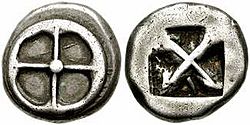 |
|
| Front: Four-spoked wheel | Back: Square shape, divided |
| Silver coin from Athens during Pisistratus's time, 545–510 BC | |
- Coins: Pisistratus or his sons started minting silver coins. These coins often had an owl on them, which was a symbol of Athena. These "owl" coins became very well-known in the Aegean Sea region.
Abroad
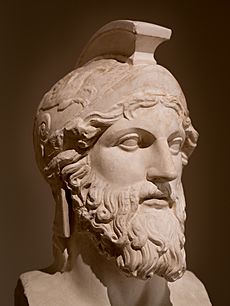
Pisistratus also worked to build alliances with friendly leaders in the central Aegean Sea.
- He helped his ally Lygdamis become the ruler of the island of Naxos.
- He took back control of the port city of Sigeion in modern-day Turkey and put one of his sons in charge there.
- He also established an Athenian presence in the Thracian Chersonese (now the Gallipoli peninsula). This area was important for trade routes between Asia and Europe. He sent Miltiades to rule there as a tyrant.
A Popular Tyrant
In ancient Greece, the word "tyrant" did not always mean a cruel ruler. People judged a tyrant by their actions. Some tyrannies were short, but others, like Pisistratus's rule, lasted a long time if people thought they were good. Tyrants took power by force, but once in charge, they often tried to pass their rule to their sons, like kings. They often gained power by getting support from the poor.
After taking power for the first time, Pisistratus ruled Athens fairly. He kept the government and laws mostly the same. However, after his third return to power in 546 BC, he became stricter. He used his soldiers, increased his income from mines, and held the children of his opponents hostage on Naxos. He also exiled some opponents. These actions show that his rule was not always completely fair.
Still, many historians describe Pisistratus's rule as moderate and mild. He was known for being pleasant. One story tells of a man farming a very rocky piece of land. When asked what his land produced, the man joked that it produced "soreness and aches," and Pisistratus received one-tenth of that. Because of his honesty, Pisistratus excused the man from paying taxes. Some historians say Pisistratus's government felt more like a regular government than a harsh tyranny.
Legacy and What Happened Next
Pisistratus died in 527 or 528 BC. His oldest son, Hippias, became the next tyrant of Athens. Hippias and his brother, Hipparchus, continued many of their father's laws. They also taxed Athenians at no more than five percent of their income.
In 514 BC, two men, Harmodius and Aristogeiton, tried to kill both brothers. They only managed to kill Hipparchus. Hippias remained in power for four more years. During this time, he became more suspicious and harsh, killing many Athenians.
The Alcmaeonid family helped end the tyranny. They bribed the Delphic oracle to tell the Spartans to free Athens. In 510 BC, the Spartans helped overthrow Hippias. Hippias and the other Pisistratids were forced to leave Athens.
| Obol of Athens, 545–525 BC | |
|---|---|
 |
|
| Front: An ancient Gorgon face | Back: Square shape |
| An ancient silver coin from Athens during Pisistratus's time, 545–525 BC | |
Hippias later joined the court of King Darius of Persia. He helped the Persians attack Marathon in 490 BC during the Greco-Persian Wars.
After the fall of the Pisistratid rule in 510 BC, Cleisthenes became a powerful leader in Athens. He created new tribes for citizens and a council of 500 representatives. This led to the beginning of democratic government in Athens around 508 BC. Pisistratus's rule, even as a tyranny, helped set the stage for this democracy. It helped create a more equal society for people outside the ruling family.
When Pisistratus died, Athens was becoming a strong and unified society. Even though Sparta was still more powerful, Athens was growing. Many people called Pisistratus's time in power "the age of gold." This was a reference to a mythical time of peace and happiness.
Later, in the time of Athenian democracy, a practice called ostracism was created. This allowed citizens to vote to expel someone from the city for up to ten years. This was partly a way to protect against new tyrants or people who became too powerful.
The poet Dante mentioned Pisistratus in his famous work, the Divine Comedy. He described Pisistratus as responding gently to an admirer of his daughter.
Some stories say Pisistratus's bodyguards were called "wolf-feet." This was either because they wore wolf-skins on their feet or had a wolf symbol on their shields.
See also
 In Spanish: Pisístrato para niños
In Spanish: Pisístrato para niños
- Land reform in Athens
- Stasis (ancient Greece)


